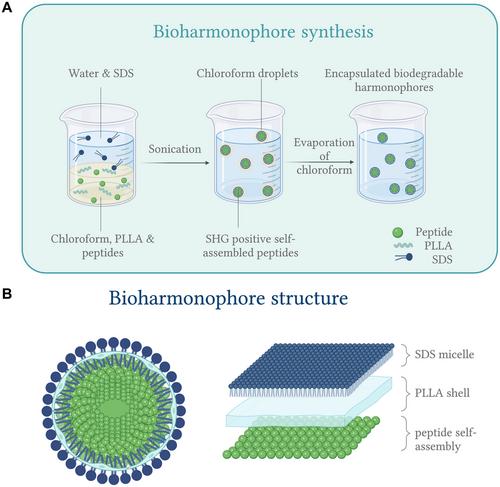Edagul Ulucay, Pomone Bollier, Marina Spilioti, Ali Yasin Sonay, Konstantinos Kalyviotis, Periklis Pantazis
{"title":"用于细胞靶向的可生物降解二次谐波发生纳米探针的合成与功能化。","authors":"Edagul Ulucay, Pomone Bollier, Marina Spilioti, Ali Yasin Sonay, Konstantinos Kalyviotis, Periklis Pantazis","doi":"10.1002/cpz1.1089","DOIUrl":null,"url":null,"abstract":"<p>Optical imaging technologies and cell targeting have played a major role in detecting and treating diseases such as cancer. Bioharmonophores are optical imaging nanoprobes composed of biodegradable polymer–encapsulated, self-assembling triphenylalanine peptides. They produce a strong second harmonic generation (SHG) signal, a non-linear optical process in which two photons directed at a non-centrosymmetric medium combine to form a new photon with twice the energy. Bioharmonophores demonstrate superior optical properties compared to fluorescent probes and, unlike previously developed inorganic SHG nanoprobes, are both biocompatible and biodegradable. Here, we present a protocol providing five detailed procedures that describe (1) synthesis of bioharmonophores; (2) embedding and imaging of the synthesized SHG nanoprobes in polyacrylamide gel; (3) functionalization of bioharmonophores with thiol-containing polyethyleneglycol; (4) subsequent click chemistry to target cancer cells; and (5) imaging of functionalized bioharmonophores endocytosed by cancer cells using two-photon microscopy. Bioharmonophores hold great potential as clinical contrast agents due to their optical features and could be used in the future as an innovative approach to cancer treatment using targeted high-resolution optical imaging. © 2024 The Author(s). Current Protocols published by Wiley Periodicals LLC.</p><p><b>Basic Protocol 1</b>: Synthesis of bioharmonophores</p><p><b>Basic Protocol 2</b>: Imaging of bioharmonophores in polyacrylamide gel</p><p><b>Basic Protocol 3</b>: Functionalization of bioharmonophores with thiol-PEG</p><p><b>Basic Protocol 4</b>: Functionalization of thiol-PEGylated bioharmonophores with peptides</p><p><b>Basic Protocol 5</b>: Targeting of cancer cells with functionalized bioharmonophores</p>","PeriodicalId":93970,"journal":{"name":"Current protocols","volume":"4 7","pages":""},"PeriodicalIF":0.0000,"publicationDate":"2024-07-22","publicationTypes":"Journal Article","fieldsOfStudy":null,"isOpenAccess":false,"openAccessPdf":"https://onlinelibrary.wiley.com/doi/epdf/10.1002/cpz1.1089","citationCount":"0","resultStr":"{\"title\":\"Synthesis and Functionalization of Biodegradable Second Harmonic Generation Nanoprobes for Cell Targeting\",\"authors\":\"Edagul Ulucay, Pomone Bollier, Marina Spilioti, Ali Yasin Sonay, Konstantinos Kalyviotis, Periklis Pantazis\",\"doi\":\"10.1002/cpz1.1089\",\"DOIUrl\":null,\"url\":null,\"abstract\":\"<p>Optical imaging technologies and cell targeting have played a major role in detecting and treating diseases such as cancer. Bioharmonophores are optical imaging nanoprobes composed of biodegradable polymer–encapsulated, self-assembling triphenylalanine peptides. They produce a strong second harmonic generation (SHG) signal, a non-linear optical process in which two photons directed at a non-centrosymmetric medium combine to form a new photon with twice the energy. Bioharmonophores demonstrate superior optical properties compared to fluorescent probes and, unlike previously developed inorganic SHG nanoprobes, are both biocompatible and biodegradable. Here, we present a protocol providing five detailed procedures that describe (1) synthesis of bioharmonophores; (2) embedding and imaging of the synthesized SHG nanoprobes in polyacrylamide gel; (3) functionalization of bioharmonophores with thiol-containing polyethyleneglycol; (4) subsequent click chemistry to target cancer cells; and (5) imaging of functionalized bioharmonophores endocytosed by cancer cells using two-photon microscopy. Bioharmonophores hold great potential as clinical contrast agents due to their optical features and could be used in the future as an innovative approach to cancer treatment using targeted high-resolution optical imaging. © 2024 The Author(s). Current Protocols published by Wiley Periodicals LLC.</p><p><b>Basic Protocol 1</b>: Synthesis of bioharmonophores</p><p><b>Basic Protocol 2</b>: Imaging of bioharmonophores in polyacrylamide gel</p><p><b>Basic Protocol 3</b>: Functionalization of bioharmonophores with thiol-PEG</p><p><b>Basic Protocol 4</b>: Functionalization of thiol-PEGylated bioharmonophores with peptides</p><p><b>Basic Protocol 5</b>: Targeting of cancer cells with functionalized bioharmonophores</p>\",\"PeriodicalId\":93970,\"journal\":{\"name\":\"Current protocols\",\"volume\":\"4 7\",\"pages\":\"\"},\"PeriodicalIF\":0.0000,\"publicationDate\":\"2024-07-22\",\"publicationTypes\":\"Journal Article\",\"fieldsOfStudy\":null,\"isOpenAccess\":false,\"openAccessPdf\":\"https://onlinelibrary.wiley.com/doi/epdf/10.1002/cpz1.1089\",\"citationCount\":\"0\",\"resultStr\":null,\"platform\":\"Semanticscholar\",\"paperid\":null,\"PeriodicalName\":\"Current protocols\",\"FirstCategoryId\":\"1085\",\"ListUrlMain\":\"https://onlinelibrary.wiley.com/doi/10.1002/cpz1.1089\",\"RegionNum\":0,\"RegionCategory\":null,\"ArticlePicture\":[],\"TitleCN\":null,\"AbstractTextCN\":null,\"PMCID\":null,\"EPubDate\":\"\",\"PubModel\":\"\",\"JCR\":\"\",\"JCRName\":\"\",\"Score\":null,\"Total\":0}","platform":"Semanticscholar","paperid":null,"PeriodicalName":"Current protocols","FirstCategoryId":"1085","ListUrlMain":"https://onlinelibrary.wiley.com/doi/10.1002/cpz1.1089","RegionNum":0,"RegionCategory":null,"ArticlePicture":[],"TitleCN":null,"AbstractTextCN":null,"PMCID":null,"EPubDate":"","PubModel":"","JCR":"","JCRName":"","Score":null,"Total":0}
引用次数: 0
Synthesis and Functionalization of Biodegradable Second Harmonic Generation Nanoprobes for Cell Targeting
Optical imaging technologies and cell targeting have played a major role in detecting and treating diseases such as cancer. Bioharmonophores are optical imaging nanoprobes composed of biodegradable polymer–encapsulated, self-assembling triphenylalanine peptides. They produce a strong second harmonic generation (SHG) signal, a non-linear optical process in which two photons directed at a non-centrosymmetric medium combine to form a new photon with twice the energy. Bioharmonophores demonstrate superior optical properties compared to fluorescent probes and, unlike previously developed inorganic SHG nanoprobes, are both biocompatible and biodegradable. Here, we present a protocol providing five detailed procedures that describe (1) synthesis of bioharmonophores; (2) embedding and imaging of the synthesized SHG nanoprobes in polyacrylamide gel; (3) functionalization of bioharmonophores with thiol-containing polyethyleneglycol; (4) subsequent click chemistry to target cancer cells; and (5) imaging of functionalized bioharmonophores endocytosed by cancer cells using two-photon microscopy. Bioharmonophores hold great potential as clinical contrast agents due to their optical features and could be used in the future as an innovative approach to cancer treatment using targeted high-resolution optical imaging. © 2024 The Author(s). Current Protocols published by Wiley Periodicals LLC.
Basic Protocol 1: Synthesis of bioharmonophores
Basic Protocol 2: Imaging of bioharmonophores in polyacrylamide gel
Basic Protocol 3: Functionalization of bioharmonophores with thiol-PEG
Basic Protocol 4: Functionalization of thiol-PEGylated bioharmonophores with peptides
Basic Protocol 5: Targeting of cancer cells with functionalized bioharmonophores


 求助内容:
求助内容: 应助结果提醒方式:
应助结果提醒方式:


